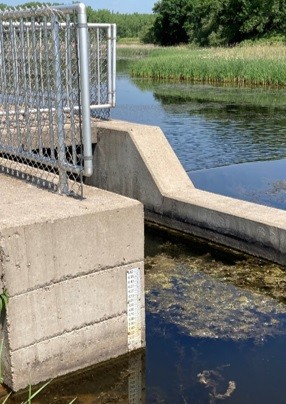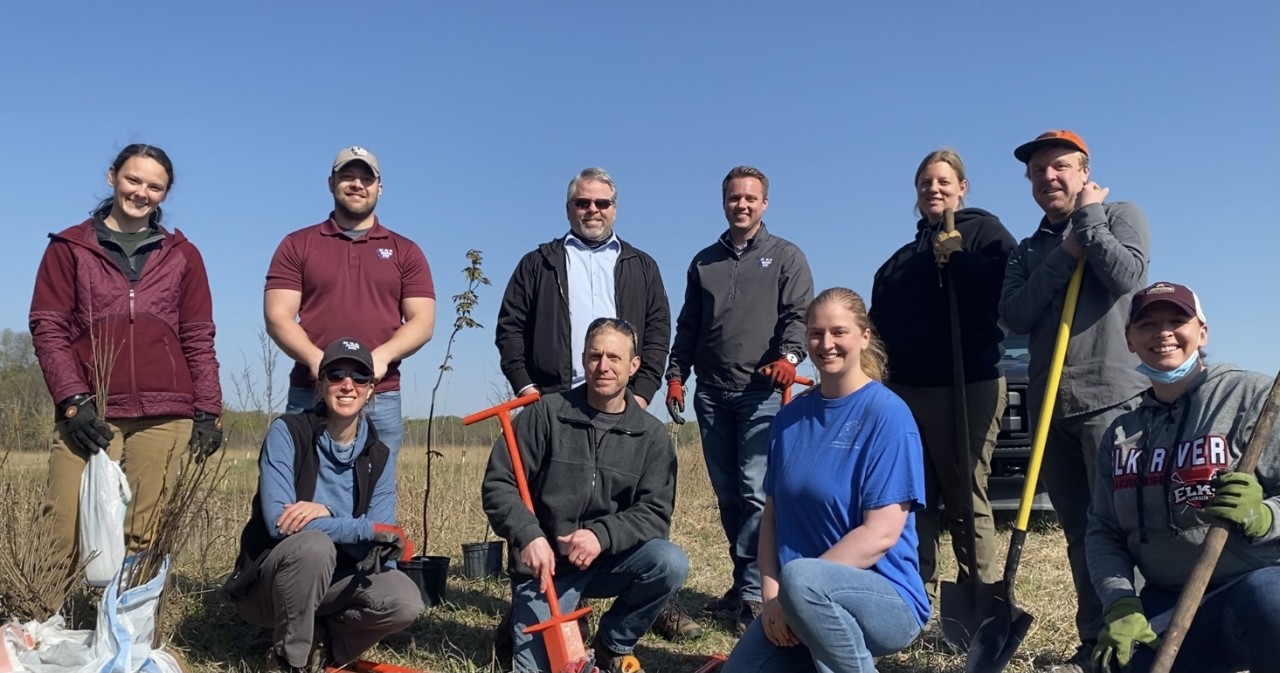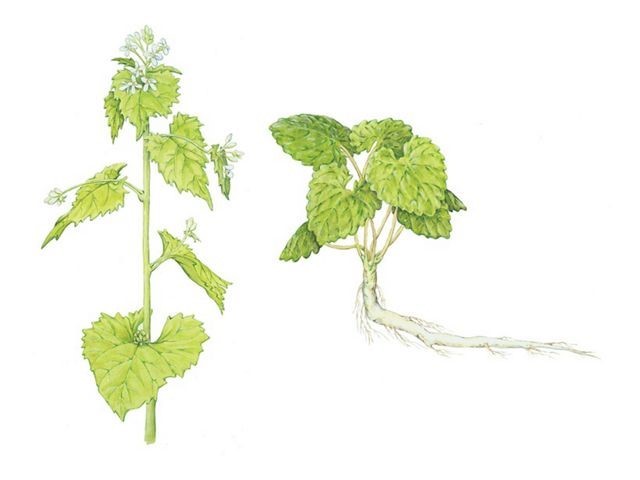On June 7th, 2021, the Anoka Conservation District celebrated its 75th Anniversary serving Anoka County. Coincidentally, District Manager, Chris Lord, also celebrated an anniversary that same day – 30 years with the District. To honor this significant accomplishment, we sat down with Chris to look back at what inspired him to pursue a long career in Natural Resource Management and revisit some memories of his time working at ACD.
Emily Johnson, Outreach Coordinator: Thank you for taking the time to chat today, Chris! And thank you from all of us for your 30 years of dedicated service to ACD and Anoka County. Before we get into what drew you to the field of Natural Resource Management, can you tell us more about yourself and what sorts of things keep your mind occupied?
Chris Lord, District Manager: I'm a solitary soul. Fortunately for me, my beautiful wife is too. We enjoy solitude together, and often spend it puttering around the house with home improvements, working in the yard, and enjoying a good show. When I want to be solitary alone, I am drawn toward quandary solving. I love a good puzzle. Not the jigsaw kind. The logic kind. I think this is one reason I like working in the natural resources stewardship field. To understand the problem, you need to consider physics, chemistry, geology, hydrology, and biology and to address the problem you need to layer in politics, sociology, economics, psychology, and diplomacy. On a simpler level, give me a good killer Sudoku with a ridiculous set of rules and I'll be content solving it for the better part of an hour.
Johnson: Managing our natural resources can certainly be a puzzle at times with many interconnected factors to consider. It's a good thing you thrive when solving complex problems! I understand you grew up in Blaine; can you share some of your favorite memories of your childhood growing up in Anoka County?
Lord: I grew up in a neighborhood in northern Blaine with many kids in every house. We all belonged to multiple crews depending on interests, and as our interests ebbed and flowed, so did our allegiances. One contingent of kids to which I belonged spent many of our summer days out in the woods, wetlands, and fields. We'd build and use BMX and motocross tracks, build forts, transplant trees to our yards, and explore. On one outing we discovered that cattail seed heads when full ripe could be turned into an enduring cloud of downy fluff. We proceeded to release every seed in the swamp until the entire crusted over swamp was four to five feet deep in downy whiteness. This set the stage for the most unique game of tag I'd ever be involved in. Despite it being broad daylight, intermittently we were unable to see two feet in front of our faces due to the calamity of seed and had to play mostly by sound. There were some collisions. On one occasion, we decided to clean up our daytime retreat and so traipsed out to the woods with garbage bags in hand. We returned with what seemed to us to be a ton of trash and were thereafter dubbed the Swamp Dusters; a moniker not likely to strike fear in the hearts of the other neighborhood crews, but we kept it nonetheless. The woods, fields, and wetlands that were our stomping grounds are now the Majestic Oaks Golf Course south nine.
Johnson: Like many of us in the natural resource and stewardship field, it sounds like you grew up with a deep love and reverence for our natural world. When you think of your connection to nature and our natural resources today, what do you think of?
Lord: For me, the best part of nature are the quite places that make the worries of life fade into oblivion. The movement of leaves in treetops giving voice to the wind, the layers of aroma hinting at the often unseen players in the landscape, the darting action of little critters seen only in the periphery; these are the distractions and attractions that connect me to nature and make possible exploration all while sitting motionless, not making a sound.
Johnson: It certainly makes sense why you've dedicated your life in service to our natural resources! Can you tell us about a lasting memory you have of your career in natural resources and your time working with ACD?
Lord: The memories that stand out most clearly are the times things didn't go well. In my early twenties, I offended a public official by repeating a question in a public forum after she had just tried to dodge it. That simple act of political tone-deafness had repercussions that extended for many years. A resident threatened to throw me in a wood chipper because I undiplomatically pointed out that he shouldn't have built his pole building in a wetland and was consequentially prohibited from creating a wide driveway all the way around it. Another landowner seeking a favorable wetland delineation asked what would happen if he dropped a hundred dollar bill. I assured him I'd return it to him. I once overheard a well-respected and well-compensated wetland expert explain to his new staff member in the field that because they were considered the experts, they could convince the local government staff and officials of anything because the locals didn't understand the science and would trust expert testimony. These memories, along with countless other experiences, did more to sharpen my diplomacy, political astuteness, customer service, communication, and ethical fortitude than did my successes or mastery of the sciences. Overall, the public is better served by civil servants with well-honed soft skills than those who talents are limited to technical proficiency.
Johnson: Your stories show that we often learn more from our mistakes than we do from our successes. While it's true we face many challenges in our line of work, what has kept you motivated all these years?
Lord: ACD has been a wonderful place to work on several levels. The natural resource base in the Anoka Sand Plain is interesting and unique and the land use varies from densely urban cityscapes to prehistorically pristine open space. The variety keeps things interesting and the people keep it enjoyable. While I've seen a lot of colleagues come and go over the decades, I can count on the lesser part of one hand the number that I wouldn't fully enjoy working with. The elected Board of Supervisors during my term at ACD has always, without exception, served to the best interest of the natural resources and residents without ever putting self-interest first. I find this extraordinary. The Board manages to provide an optimal balance of guidance and flexibility. This has allowed ACD staff to innovate extensively in our pursuit to fulfill ACD's objectives. None of it would have come together without partnering with other local government staff and residents. Working hand-in-hand with these cohorts in conservation is very gratifying.
Johnson: Thank you, Chris, for sharing your stories and thank you again for your continued service to Anoka County!
In this year of milestones, we want to recognize and thank the rest of our staff and supervisors who are also celebrating anniversaries with the District. The District has many things to celebrate, but the most important is the Staff and Board members that have worked hard to make ACD so successful in their conservation efforts. Some have been with ACD for a short time, while others have worked at ACD for decades. Below is a list of employees and supervisors along with their length of time with ACD. They all deserve a big shout out!
ACD Staff:
Chris Lord, District Manager – 30 years
Jamie Schurbon, Watershed Projects Manager – 20 years
Kathy Berkness, Office Administrator – 16 years
Becky Wozney, Wetland Specialist – 16 years
Mitch Haustein, Stormwater and Shoreland Specialist – 11 years
Jared Wagner, Water Resource Specialist – 5 years
Carrie Taylor, Restoration Ecologist – 5 years
Kris Larson, Water Resource Technician – 5 years
Emily Johnson, Outreach and Engagement Coordinator – 3 years
Mollie Annen, Natural Resource Conservationist – 1 year
Kat Dickerson, District Technician – 2 months
ACD Board Supervisors:
Mary Jo Truchon, Board Chair – 25 years
Jim Lindahl, Vice Chair – 12 years
Glenda Meixell, Treasurer – 4 years
Sharon LeMay, Member – 4 years
Colleen Werdien, Member – 6 months




